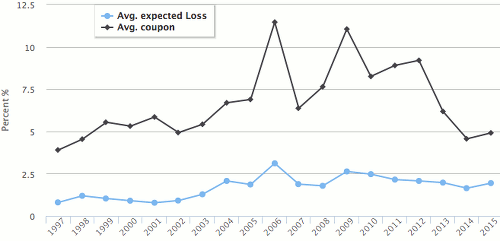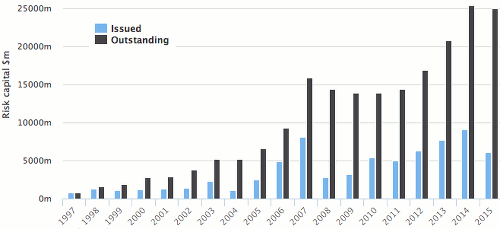Reinsurance industry analysts, experts and participants have noted that pricing in the sector will likely be at a structurally lower level than before, owing to the influx and permanence of alternative capital, a notion echoed recently by Moody’s Investor Services.
Insurance and reinsurance ratings agency Moody’s has reiterated the views of other reinsurance sector analysts in recent times, including Goldman Sachs and Credit Suisse, that alternative reinsurance capital’s impact on the sector will most likely mean structurally lower returns for reinsures in the future.
“However, growth in alternative capital remains a feature, which we believe signals structurally lower returns for the reinsurance market going forward,” noted Moody’s analyst Helena Pavicic.
Pavicic explains that pricing in the catastrophe bond space, which according to reinsurer Aon Benfield accounts for just shy of 50% of overall alternative reinsurance capital, has continued to ease during H1 2015. Also noting, as highlighted by Willis Re recently, that signs are emerging of a more rational marketplace and perhaps an equilibrium between the supply and demand of reinsurance is becoming more apparent.
While this points to some, albeit minimal relief for reinsurers that have been forced to accept lower rates in recent years due to heightened competition from the insurance-linked securities (ILS) and alternative capital players, Moody’s stress that although more stable returns are expected, this will be at a structurally lower level than years gone by.
So far in 2015 notes Moody’s, utilising data from the Artemis Deal Directory, cat bond issuances have for the most part priced at the midpoint of initial price guidance or above it, signalling that albeit modest, stabilisation in cat bond pricing is evident. Furthermore, for the first time since 2011 the average catastrophe bond coupon rate increased in 2015 compared with previous years, said Moody’s.
Pavicic expands on this; “A more price rational catastrophe bond market would offer some relief to traditional reinsurers, which have had to compete away not only on price, but by offering wider terms and conditions that include more perils or allow more time for aggregating losses.”
Exactly how much of a relief more stable cat bond spreads hold for reinsurers remains to be seen, and further growth of the alternative reinsurance market coupled with a continuation of benign loss activity suggests discipline will be ever more vital moving forward.
One thing does seem certain though, the glut of alternative reinsurance capital is here to stay and it’s going to expand its volume and reach into other re/insurance business lines, including casualty, and other geographies.
The chart above details the growth of the outstanding catastrophe bond market, something we’ve tracked on Artemis since the markets inception many, many years ago, showing consistent growth with record levels of issuance occurring over the last 18 months.
Add to this the rise in the acceptance and therefore use of collateralized reinsurance ventures, reinsurance sidecars and an increased use of retrocession from reinsurers, and it’s no surprise that Aon Benfield recently reported that the alternative reinsurance market had grown by 6% in the first-half of 2015, compared with traditional reinsurance declining its share of the global reinsurance sector by 3%.
The burgeoning growth of the alternative, or third-party reinsurance market is credit negative for the reinsurance market explains Moody’s.
“Alternative capital typically has lower return requirements compared with traditional reinsurers, and given that we expect it to not only remain in the industry but continue growing, it signals structurally lower returns for the sector as a whole going forward,” said the ratings agency.
Another factor of alternative capital that further points to structurally lower returns for global reinsurers and a threat to the traditional reinsurance business models, notes Moody’s, is with third-party capital’s imminent expansion into new geographies and business lines.
The majority of outstanding alternative reinsurance capacity is concerned with U.S. perils, as they are more developed and easier to model and therefore adequately price. But as modelling capabilities for emerging markets and perils increases and investor appetite for alternative capital in new markets and business lines grows too, Moody’s expects alternative reinsurance capital to “win market share in other lines e.g. European windstorm, going forward.”
“Therefore, despite strong signs that a more rational marketplace is emerging in terms of pricing, the expansion of alternative capital markets continues to threaten the traditional reinsurance business models,” concludes Moody’s.
 View all of our Artemis Live video interviews and subscribe to our podcast.
View all of our Artemis Live video interviews and subscribe to our podcast.
All of our Artemis Live insurance-linked securities (ILS), catastrophe bonds and reinsurance video content and video interviews can be accessed online.
Our Artemis Live podcast can be subscribed to using the typical podcast services providers, including Apple, Google, Spotify and more.

































